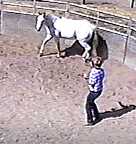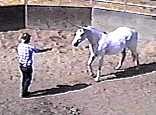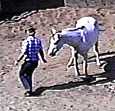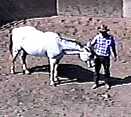| Once you have established the draw, you can progress to "leading off-line." The horse should remain focused on his position relative to yours. In this picture I'm actually walking toward the horse and he is backing up. We went forward and back several times. Until I became completely relaxed (neutral), he maintained the separation which I had established. |
|
| In this image I am now walking around the horse and if you notice his legs, he is actually doing a turn over the forehand in order to maintain his position relative to mine. He knows exactly where I am (including my feet) and he is very attentive to my movement and signals. By varying the diameter of my circle and whether I am walking into him or around him, I can get him to turn over the forehand, over the haunches or spin in place. |
|
| As soon as I go "neutral" and invite him into my space, he will come in. He is relaxed, knows what's going on, is comfortable with me being the boss, and now he gets a reward of a neck rub and some withers scratches for a job well done. |
|
Return to Part TwoFor related information, see "Staying a Kick Away".Continue to "Longe Line Logic"."Working a Wild Horse in a Round Pen".Important Note: If you take on the project of developing an untrained horse, everybody will want to give you advice. Don't act on any advice, including the ideas offered in this site, unless it makes sense to you and fits your individual situation. Your abilities and the sensitivities of your horse(s) may differ from the examples given. Be alert and rational with your actions so neither you nor your horse will get hurt. This information is offered as illustrations of what we do and the reader must apply common sense since he or she is solely responsible for his or her actions. Happy trails! Press "Back" to return to the page that brought you hereGo to Case Study SectionReturn to Training SectionReturn to Wild Horse MentorsReturn to KBR World of Wild Horses and BurrosGo To
| |




